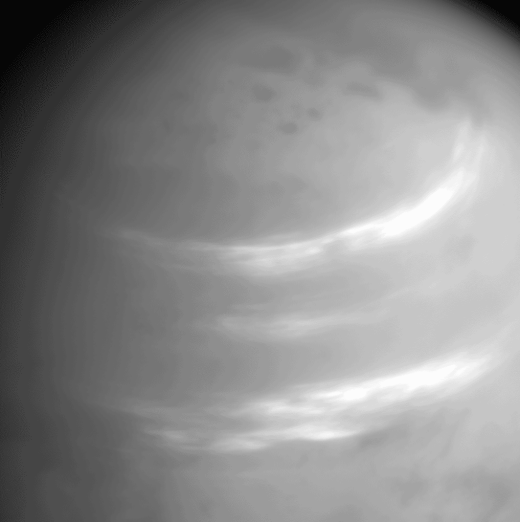Some recent imagery from NASA spacecraft:
** Jupiter’s Clouds of Many Colors | NASA (Click for larger image)

NASA’s Juno spacecraft was racing away from Jupiter following its seventh close pass of the planet when JunoCam snapped this image on May 19, 2017, from about 29,100 miles (46,900 kilometers) above the cloud tops. The spacecraft was over 65.9 degrees south latitude, with a lovely view of the south polar region of the planet.
This image was processed to enhance color differences, showing the amazing variety in Jupiter’s stormy atmosphere. The result is a surreal world of vibrant color, clarity and contrast. Four of the white oval storms known as the “String of Pearls” are visible near the top of the image. Interestingly, one orange-colored storm can be seen at the belt-zone boundary, while other storms are more of a cream color.
JunoCam’s raw images are available for the public to peruse and process into image products at: www.missionjuno.swri.edu/junocam
More information about Juno is at: http://www.nasa.gov/juno and http://missionjuno.swri.edu
Credits: NASA/JPL-Caltech/SwRI/MSSS/Gerald Eichstädt /Seán Doran
** Cassini: The Grand Finale: Grooves and Kinks in the Rings (Click for larger image)

Many of the features seen in Saturn’s rings are shaped by the planet’s moons. This view from NASA’s Cassini spacecraft shows two different effects of moons that cause waves in the A ring and kinks in the F ring.
The A ring, which takes up most of the image on the left side, displays waves caused by orbital resonances with moons that orbit beyond the rings. Kinks, clumps and other structures in the F ring (the small, narrow ring at right) can be caused by interactions between the ring particles and the moon Prometheus, which orbits just interior to the ring, as well as collisions between small objects within the ring itself.
This view looks toward the sunlit side of the rings from about 22 degrees above the ring plane. The image was taken in visible light with the Cassini spacecraft narrow-angle camera on March 22, 2017.
The view was acquired at a distance of approximately 63,000 miles (101,000 kilometers) from Saturn and at a Sun-Saturn-spacecraft, or phase, angle of 7 degrees. Image scale is 1,979 feet (603 meters) per pixel.
** Cassini: The Grand Finale: Northern Summer on Titan (Click for larger image)

NASA’s Cassini spacecraft sees bright methane clouds drifting in the summer skies of Saturn’s moon Titan, along with dark hydrocarbon lakes and seas clustered around the north pole.
Compared to earlier in Cassini’s mission, most of the surface in the moon’s northern high latitudes is now illuminated by the sun. (See here for a view of the northern hemisphere from 2007.) Summer solstice in the Saturn system occurred on May 24, 2017.
The image was taken with the Cassini spacecraft narrow-angle camera on June 9, 2017, using a spectral filter that preferentially admits wavelengths of near-infrared light centered at 938 nanometers. Cassini obtained the view at a distance of about 315,000 miles (507,000 kilometers) from Titan.
The Cassini mission is a cooperative project of NASA, ESA (the European Space Agency) and the Italian Space Agency. The Jet Propulsion Laboratory, a division of Caltech in Pasadena, California, manages the mission for NASA’s Science Mission Directorate, Washington. The Cassini orbiter and its two onboard cameras were designed, developed and assembled at JPL. The imaging operations center is based at the Space Science Institute in Boulder, Colorado.
For more information about the Cassini-Huygens mission visit https://saturn.jpl.nasa.gov and https://www.nasa.gov/cassini.









